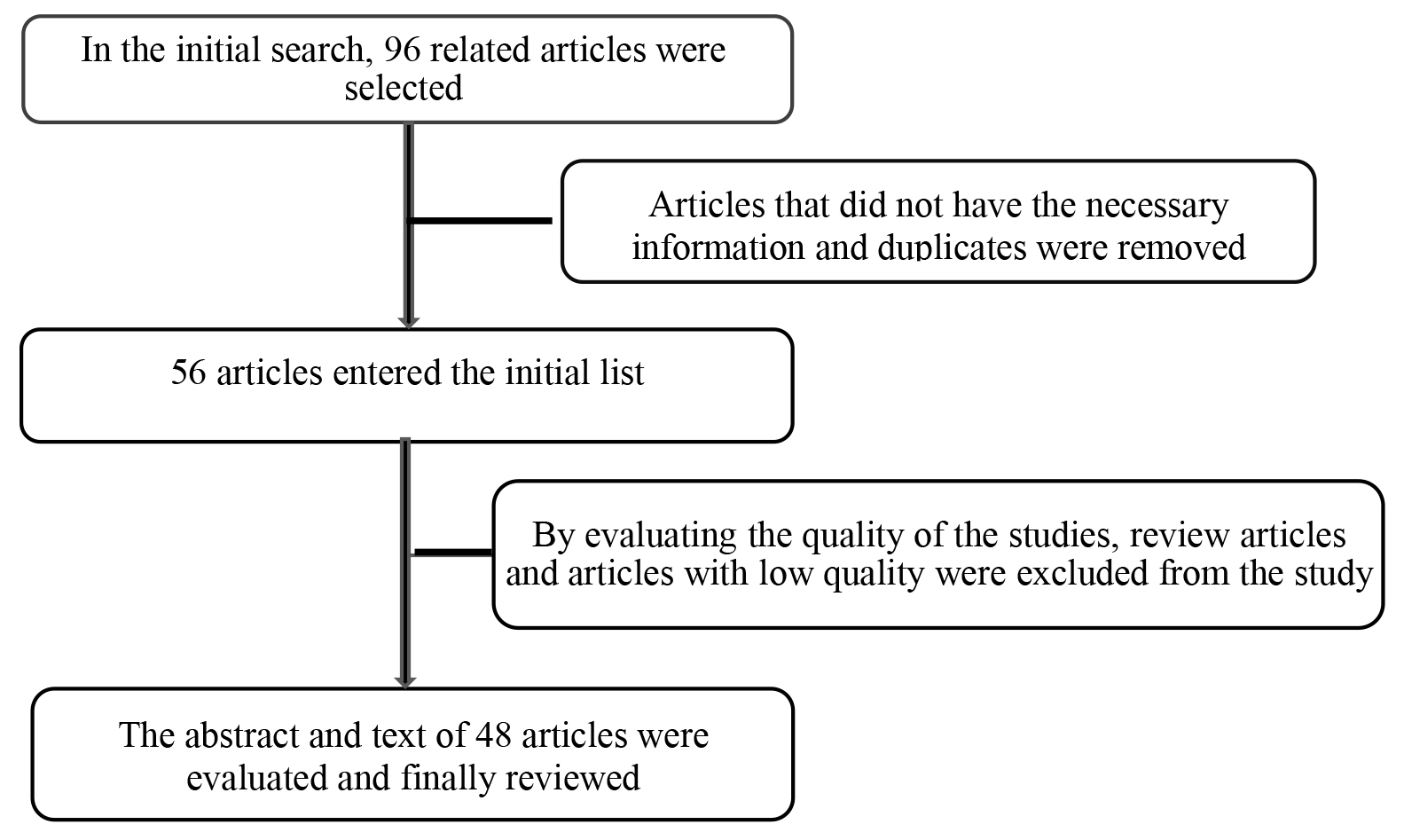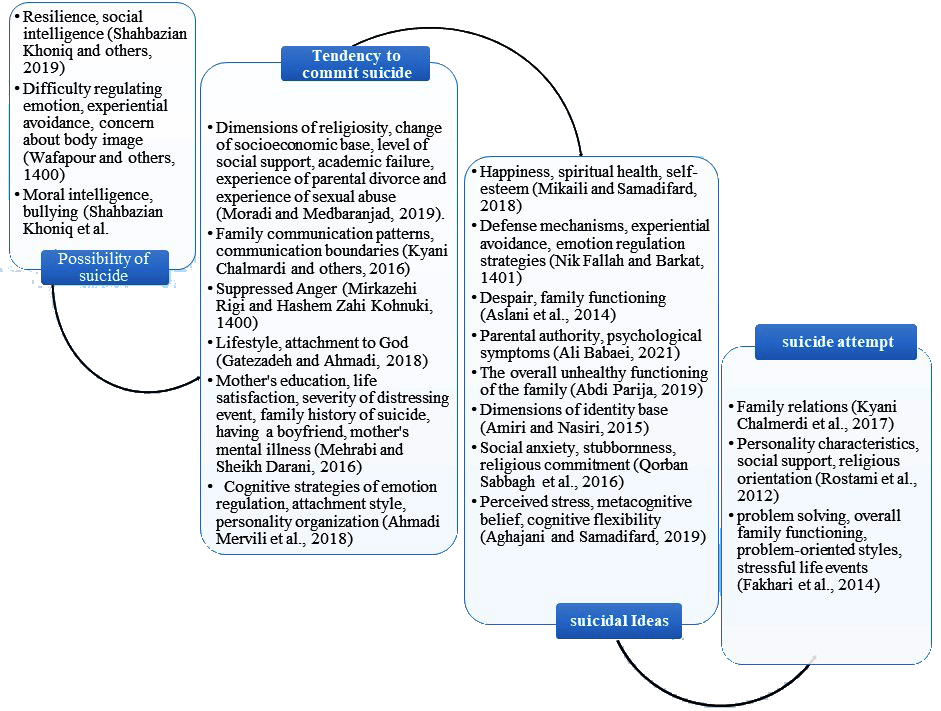Volume 24, Issue 95 (12-2024)
refahj 2024, 24(95): 87-128 |
Back to browse issues page
Download citation:
BibTeX | RIS | EndNote | Medlars | ProCite | Reference Manager | RefWorks
Send citation to:



BibTeX | RIS | EndNote | Medlars | ProCite | Reference Manager | RefWorks
Send citation to:
Ramzanzadeh Z, Amraei K, Ghazanfari F. (2024). Prevention of suicide in Iranian teenagers; A scoping review. refahj. 24(95), : 3 doi:10.32598/refahj.24.95.4448.1
URL: http://refahj.uswr.ac.ir/article-1-4276-en.html
URL: http://refahj.uswr.ac.ir/article-1-4276-en.html
Full-Text [PDF 1587 kb]
(3824 Downloads)
| Abstract (HTML) (2643 Views)
Full-Text: (2122 Views)
Extended Abstract
Introduction
Suicide, defined as an intentional act causing one’s death (Stedman, 2006), is a global social problem and a threat to individual and governmental security (Alijan, 2023). The risk of suicide is complex, involving biological, psychological, clinical, social, and environmental factors (Turecki et al., 2019). Adolescents experience physical and psychological changes that can lead to anxiety, stress, and loss of control, potentially resulting in suicidal thoughts (Keon et al., 2022). Attempted suicide among adolescents is a significant public health concern due to its frequency, associated physical and psychological problems, and economic complications. Suicide attempters are considered a high-risk group for eventual suicide (Espirito et al., 1989). Focused research on total suicide among youth under 18 across countries and cultures is necessary to understand the risk as children progress toward adolescence (McLaughlin, Gould, & Malone, 2015). This period, often marked by the onset of suicidal thoughts and behaviors, offers opportunities to understand the causes and prevent the progression of suicidal tendencies (Stewart et al., 2017). The increasing rate of suicide attempts among teenagers, associated with changes during puberty, raises alarms for mental health professionals and therapists regarding the prevention and control of this social concern.
Method
This scoping review was conducted by systematically searching various scientific databases and search engines, including Ensani, SID, Magiran, Noormags, Google Scholar, Scopus, PubMed, and ScienceDirect. The search strategy involved the use of Persian keywords such as “خودکشی” (suicide), “نوجوان” (teenager), “دانشآموز” (student), and “ایران” (Iran). A specific and comprehensive search strategy was employed to identify relevant articles. The entire process of this study is detailed in the flow chart below. This revision maintains the original tone and content.
Findings
To categorize, analyze, and summarize the data more effectively, the studies were initially divided into two main research types. The first category included studies investigating the factors influencing suicide. The second category consists of studies focused on developing psychological interventions and evaluating their effectiveness on suicide variables, encompassing experimental and quasi-experimental interventional studies. Different statistical methods were employed in these two categories to investigate further suicide-related variables, in line with the purpose of each study.
Classification based on the nature of research data is a common approach in research methods. Thus, the investigated studies were divided into two groups: “quantitative” and “qualitative” research. The first group of studies, comprising non-experimental/descriptive research focused on risk factors or underlying variables related to suicide, was further subdivided into qualitative phenomenological studies and qualitative studies using the content analysis method, as well as descriptive-analytical (cross-sectional) studies. The second group included quantitative studies and descriptive correlational studies.
By reviewing and summarizing 35 valid articles, various reasons were identified. The review of the first group’s research on the causes and motivations of suicidal thoughts and behavior indicated that qualitative studies, often employing interviews for data collection, identified certain risk, protective, and effective factors related to suicide (suicidal tendencies, suicidal thoughts, and suicide attempts).
The results of 16 studies revealed that these factors could be classified into two main groups: individual factors (including demographic, physical, cognitive, emotional, and religious information) and background factors (including social and family factors). The table below summarizes these factors, the authors’ names, and the articles’ publication years.
This revised version maintains the original length while using precise, technical, and academic language suitable for an extensive abstract.
Many studies measured the significance and relationship between variables using Pearson’s correlation coefficient. They also discussed the predictability of changes in dependent variables through independent variables using regression analysis. Important risk factors for clinical interventions were statistically analyzed. In Picture 1, these variables, which explain part of the variance of variables related to suicide, are illustrated.
Based on the summation of these studies, a model of factors related to adolescent suicidal behavior was drawn. This model depicts a suicide attempt as a behavior resulting from the interaction of developmental, psychological, environmental, family, and socio-cultural factors.
This revision maintains the technical and academic tone and does not reduce the content length.
Moreover, this study did not examine the interaction of risk and protective factors with suicide.
The results of 16 studies indicate that the factors contributing to suicide can be categorized into two primary groups: individual factors (including demographic, physical, cognitive, emotional, and religious information) and social factors (including social and family factors). In the second category of research, 13 articles have examined psychological interventions aimed at reducing suicidal tendencies, thoughts, and behaviors, thereby preventing suicide.
In summary, these studies confirm the effectiveness of psychological interventions on variables such as body image, social anxiety, emotion regulation strategies, anxiety and depression, high-risk behaviors, the tendency towards indirect self-destructive behaviors, suicidal thoughts and ideation, and ultimately the desire to commit suicide.
Discussion
Given the variation in prevalence, methods, and causes of suicide across Iranian subcultures, and the necessity of understanding the cultural context for the evaluation, diagnosis, and effective clinical management of disorders (Zarani & Ahmadi, 2021), future research should explore the impact of ethnic and cultural diversity among adolescents on suicide-related variables to enhance prevention and treatment strategies.
According to this research, teenage students in higher grades (second-year high school) have been the focus of a larger share of studies. Additionally, the greater representation of girls and the insufficient gender distribution in existing research underscore the need to investigate suicide-related variables in boys in future studies. Furthermore, most studies on adolescent suicide have been conducted in school and hospital settings. Given the risk factors and underlying causes of suicide, and the high vulnerability of adolescents in correctional and educational centers, there is a pressing need for more focused research on this segment of the adolescent population.
Family problems, including conflict and the collapse of family structure, are frequently mentioned social factors in these studies. This highlights the critical role of the family in Iranian culture, particularly in teenagers. The family, as a primary institution in the lives of young individuals, plays a crucial supportive role in facing social, cultural, and economic challenges (Keiwan-Ara & Haqshenas, 2011). Therefore, by improving family conditions, educating parents, and implementing psychological interventions, many variables contributing to adolescent suicide can be mitigated.
Most research conducted in Iran is cross-sectional. Considering the importance of longitudinal and prospective studies in uncovering causal relationships between variables, there is a significant gap in such research in Iran.
It should be acknowledged that most studies used Pearson’s correlation coefficient for statistical analysis and to show the linear relationships between research variables. However, as some studies are cross-sectional analyses, causal relationships between variables cannot be definitively determined. Therefore, the results and findings should be interpreted with caution.
Furthermore, this study did not examine the interaction of risk and protective factors with suicide. Future research should investigate these interactions within a comprehensive model to prevent adolescent suicide.
Ethical Considerations
This research was conducted with rigorous ethical principles. All sources were accurately cited, and appropriate permissions were obtained. The authors declare no conflicts of interest. This collaborative work, based on a doctoral dissertation in Psychology from the University of Lorestan, underscores the importance of ethical conduct in research.
This revision maintains the technical and academic tone, preserving the content’s length and detail while adhering to the conventions of extensive scientific abstracts.
Introduction
Suicide, defined as an intentional act causing one’s death (Stedman, 2006), is a global social problem and a threat to individual and governmental security (Alijan, 2023). The risk of suicide is complex, involving biological, psychological, clinical, social, and environmental factors (Turecki et al., 2019). Adolescents experience physical and psychological changes that can lead to anxiety, stress, and loss of control, potentially resulting in suicidal thoughts (Keon et al., 2022). Attempted suicide among adolescents is a significant public health concern due to its frequency, associated physical and psychological problems, and economic complications. Suicide attempters are considered a high-risk group for eventual suicide (Espirito et al., 1989). Focused research on total suicide among youth under 18 across countries and cultures is necessary to understand the risk as children progress toward adolescence (McLaughlin, Gould, & Malone, 2015). This period, often marked by the onset of suicidal thoughts and behaviors, offers opportunities to understand the causes and prevent the progression of suicidal tendencies (Stewart et al., 2017). The increasing rate of suicide attempts among teenagers, associated with changes during puberty, raises alarms for mental health professionals and therapists regarding the prevention and control of this social concern.
Method
This scoping review was conducted by systematically searching various scientific databases and search engines, including Ensani, SID, Magiran, Noormags, Google Scholar, Scopus, PubMed, and ScienceDirect. The search strategy involved the use of Persian keywords such as “خودکشی” (suicide), “نوجوان” (teenager), “دانشآموز” (student), and “ایران” (Iran). A specific and comprehensive search strategy was employed to identify relevant articles. The entire process of this study is detailed in the flow chart below. This revision maintains the original tone and content.
Flow chart of the steps of the present review study


Findings
To categorize, analyze, and summarize the data more effectively, the studies were initially divided into two main research types. The first category included studies investigating the factors influencing suicide. The second category consists of studies focused on developing psychological interventions and evaluating their effectiveness on suicide variables, encompassing experimental and quasi-experimental interventional studies. Different statistical methods were employed in these two categories to investigate further suicide-related variables, in line with the purpose of each study.
Classification based on the nature of research data is a common approach in research methods. Thus, the investigated studies were divided into two groups: “quantitative” and “qualitative” research. The first group of studies, comprising non-experimental/descriptive research focused on risk factors or underlying variables related to suicide, was further subdivided into qualitative phenomenological studies and qualitative studies using the content analysis method, as well as descriptive-analytical (cross-sectional) studies. The second group included quantitative studies and descriptive correlational studies.
By reviewing and summarizing 35 valid articles, various reasons were identified. The review of the first group’s research on the causes and motivations of suicidal thoughts and behavior indicated that qualitative studies, often employing interviews for data collection, identified certain risk, protective, and effective factors related to suicide (suicidal tendencies, suicidal thoughts, and suicide attempts).
The results of 16 studies revealed that these factors could be classified into two main groups: individual factors (including demographic, physical, cognitive, emotional, and religious information) and background factors (including social and family factors). The table below summarizes these factors, the authors’ names, and the articles’ publication years.
This revised version maintains the original length while using precise, technical, and academic language suitable for an extensive abstract.
| Individual Factors |
| 1. Demographic Information: Gender (Mokhtari et al., 2019), (Hemmati et al., 2014); Field and level of education (Bazrafshan et al., 2016), (Hemmati et al., 2014); Living in rural areas and age (Mokhtari et al., 2019), |
| 2. Physical: Maturity (Bazrafshan et al., 2016); Tensions of the maturation process (Rabiei and Gorji, 2020); Luteal phase of the menstrual cycle in girls (Mousavi et al., 2008); Drug use (Shirzad, 2017); History of psychiatric disorder, presence of physical illness, history of previous action, drug use and smoking (Hemmati et al., 2004). |
| 3. Cognitive: Early maladaptive schemas (Ahmadiangorji et al., 2008); Unattainable needs or goals (Shirzad, 2017), Psychological problems and use of ineffective coping methods (Delam and Bazarafshan, 2020); Psychological pressure, personal failure, need for attention (Rabiei and Gorji, 2020); Psycho-emotional problems, stress management strategies (Bazrafshan et al., 2016); Presence of depression symptoms and general psychological disturbances (Mohammadkhani, 2004); Psychiatric disorders such as adjustment disorder and depression (Farzaneh et al., 2010); |
| 4. Emotional: Emotional failures (Shirzad, 2017); Disruption of emotional relationships (Delam and Bazarafshan, 2020); Divorce of parents, death of relatives (Shirzad, 2017); Death of a close relative in the past year (Hemmati et al., 2004); Marriage and love (Bazrafshan et al., 2016); Romantic disappointment (Farzaneh et al., 2010); Feeling insecure (Bokharai and Zakizad, 2018) |
| 5. Spiritual: Religious discontinuity (Rabiei and Gorji, 2020); Religious beliefs (Bazrafshan et al., 2016); |
| Background Factors |
| 1. Family Factors: (family structure, family relationships, family economic characteristics, and family health conditions) (Bazrafshan et al., 2016); Marital (Faramarzian and others, 2019); Family problems (Shirzad, 2017); Collapse of the family structure (Delam and Bazarfshan, 2020); Family conflict (Delam and Bazrafshan, 2019; Mokhtari et al., 2019; Farzaneh et al., 2010); Behavioral pattern of parents (Zargham Boroujeni et al., 2001); Family functioning and marital satisfaction of parents (Babakhanipour et al., 2018) |
| 2. Social Factors (Suicidal behavior in others, media influence, professional support) (Bazrafshan et al., 2016); Membership in special groups such as Satanists certain computer programs, and virtual sites (Shirzad, 2016); Generation gap, lifestyle, economic pressure and social exclusion (loss of social capital, social pressure, and weak communication skills) (Rabiei and Gorji, 2020). |
In the second group of research, the relationship between independent variables and four dependent variables related to suicide — which leads a person towards self-inflicted death —was measured. These dependent variables include suicide probability, tendency and desire to commit suicide, ideation and thoughts of suicide, and suicide attempt.
Many studies measured the significance and relationship between variables using Pearson’s correlation coefficient. They also discussed the predictability of changes in dependent variables through independent variables using regression analysis. Important risk factors for clinical interventions were statistically analyzed. In Picture 1, these variables, which explain part of the variance of variables related to suicide, are illustrated.
Based on the summation of these studies, a model of factors related to adolescent suicidal behavior was drawn. This model depicts a suicide attempt as a behavior resulting from the interaction of developmental, psychological, environmental, family, and socio-cultural factors.
This revision maintains the technical and academic tone and does not reduce the content length.
Figure 1: Suicide trend and related factors in the studies


Moreover, this study did not examine the interaction of risk and protective factors with suicide.
The results of 16 studies indicate that the factors contributing to suicide can be categorized into two primary groups: individual factors (including demographic, physical, cognitive, emotional, and religious information) and social factors (including social and family factors). In the second category of research, 13 articles have examined psychological interventions aimed at reducing suicidal tendencies, thoughts, and behaviors, thereby preventing suicide.
In summary, these studies confirm the effectiveness of psychological interventions on variables such as body image, social anxiety, emotion regulation strategies, anxiety and depression, high-risk behaviors, the tendency towards indirect self-destructive behaviors, suicidal thoughts and ideation, and ultimately the desire to commit suicide.
Discussion
Given the variation in prevalence, methods, and causes of suicide across Iranian subcultures, and the necessity of understanding the cultural context for the evaluation, diagnosis, and effective clinical management of disorders (Zarani & Ahmadi, 2021), future research should explore the impact of ethnic and cultural diversity among adolescents on suicide-related variables to enhance prevention and treatment strategies.
According to this research, teenage students in higher grades (second-year high school) have been the focus of a larger share of studies. Additionally, the greater representation of girls and the insufficient gender distribution in existing research underscore the need to investigate suicide-related variables in boys in future studies. Furthermore, most studies on adolescent suicide have been conducted in school and hospital settings. Given the risk factors and underlying causes of suicide, and the high vulnerability of adolescents in correctional and educational centers, there is a pressing need for more focused research on this segment of the adolescent population.
Family problems, including conflict and the collapse of family structure, are frequently mentioned social factors in these studies. This highlights the critical role of the family in Iranian culture, particularly in teenagers. The family, as a primary institution in the lives of young individuals, plays a crucial supportive role in facing social, cultural, and economic challenges (Keiwan-Ara & Haqshenas, 2011). Therefore, by improving family conditions, educating parents, and implementing psychological interventions, many variables contributing to adolescent suicide can be mitigated.
Most research conducted in Iran is cross-sectional. Considering the importance of longitudinal and prospective studies in uncovering causal relationships between variables, there is a significant gap in such research in Iran.
It should be acknowledged that most studies used Pearson’s correlation coefficient for statistical analysis and to show the linear relationships between research variables. However, as some studies are cross-sectional analyses, causal relationships between variables cannot be definitively determined. Therefore, the results and findings should be interpreted with caution.
Furthermore, this study did not examine the interaction of risk and protective factors with suicide. Future research should investigate these interactions within a comprehensive model to prevent adolescent suicide.
Ethical Considerations
This research was conducted with rigorous ethical principles. All sources were accurately cited, and appropriate permissions were obtained. The authors declare no conflicts of interest. This collaborative work, based on a doctoral dissertation in Psychology from the University of Lorestan, underscores the importance of ethical conduct in research.
This revision maintains the technical and academic tone, preserving the content’s length and detail while adhering to the conventions of extensive scientific abstracts.
Type of Study: review2 |
Received: 2023/11/5 | Accepted: 2024/09/8 | Published: 2024/12/30
Received: 2023/11/5 | Accepted: 2024/09/8 | Published: 2024/12/30
Send email to the article author
| Rights and permissions | |
 |
This work is licensed under a Creative Commons Attribution-NonCommercial 4.0 International License. |








